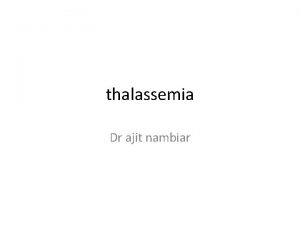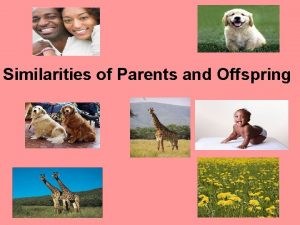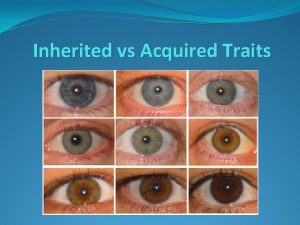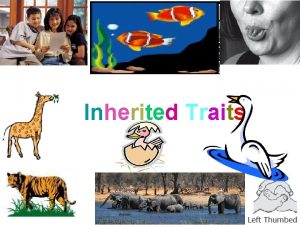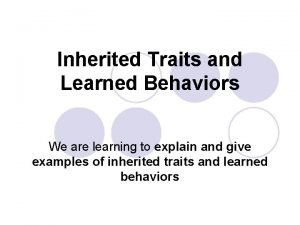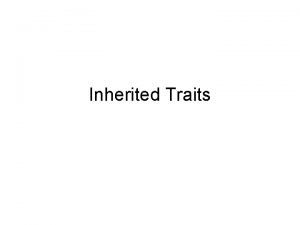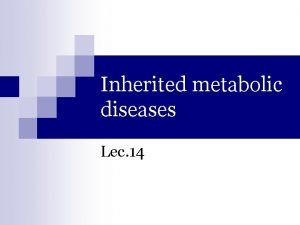A change in the inherited characteristics of a




- Slides: 4

A change in the inherited characteristics of a population over time through the process of natural selection. Cloning (Biology only) Evolution AQA GCSE INHERITANCE VARIATION AND EVOLUTION PART 3 Cloning techniques in plants/animals Tissue culture Small groups of cells to grow new plants. Important for preservation of rare plants and commercially in nurseries. Cuttings Part of a plant is cut off and grown into full plant. Embryo transplants Splitting apart cells from animals embryo before they become specialised. New clone embryos are inserted into womb of adult female. Adult cell cloning 1. Nucleus is removed from an unfertilised egg. 2. Nucleus from body cell is inserted into egg cell. 3. An electric shock stimulates the egg to divide into an embryo 4. Embryo cells are genetically identical to adult cells. 5. When embryo has developed into ball of cells it is inserted into host womb. Darwin’s finches Use current classification data for living organisms and fossil data for extinct organisms Humans have been doing this for thousands of years since they first bred food from crops and domesticated animals. The process by which humans breed plants/animals for particular genetic characteristics Selective breeding Choosing parents with the desired characteristics from a mixed population Choosing characteristics Desired characteristics are chosen for usefulness or appearance Disease resistance in food crops. Animals which produce more meat or milk. Chosen parents are bred together. Domestic dogs with a gentle nature. Genetic engineering From the offspring those with desired characteristics are bred together. Large or unusual flowers. Modern medical is exploring the possibility of GM to over come inherited disorders e. g. cystic fibrosis Repeat over several generations until all the offspring show the desired characteristics. Selective breeding Concern: effect of GMO on human health not fully explored Genetic engineering process (HT only) 1. Enzymes are used to isolate the required gene. 2. Gene is inserted into a vector – bacterial plasmid or virus. 3. Vector inserts genes into the required cells. 4. Genes are transferred to plants/animals/microbes at an early stage of development so they develop the required characteristics. Concern: some people have ethical objections to adult cell cloning e. g. welfare of the animals. better hope – brighter future Concern: effect of GMO on wild populations of flowers and insects. Genes from the chromosomes of humans or other organisms can be ‘cut out’ and transferred to the cells of other organisms. Genetically modified crops (GMO) Over time this results in the formation of new species. If two populations of one species become so different in phenotype that they can no longer interbreed to produce fertile offspring they have formed two new species. Evolutionary trees are a method used by scientists to show organisms are related Selective breeding can lead to ‘inbreeding’ where some breeds are particularly prone to disease or inherited defects e. g. British Bulldogs have breathing difficulties. The theory of evolution by natural selection. Species of all living things have evolved from simple life forms that first developed 3 billion years ago. Classification of living organisms Through natural selection of variants (genotypes) that give rise to phenotypes best suited to their environment or environmental change e. g. stronger, faster. This allows for variants to pass on their genotype to the next generation. Crops that have genes from other organisms To become more resistant to insect attack or herbicides. To increase the yield of the crop.

Over time this results in the formation of new species. If two populations of one species become so different in phenotype that they can no longer interbreed to produce fertile offspring they have formed two new species. A change in the inherited characteristics of a population over time through the process of natural selection. Cloning (Biology only) 1. Nucleus is removed from an unfertilised egg. 2. Nucleus from body cell is inserted into egg cell. 3. An electric shock stimulates the egg to divide into an embryo 4. Embryo cells are genetically identical to adult cells. 5. When embryo has developed into ball of cells it is inserted into host womb. Evolution AQA GCSE INHERITANCE VARIATION AND EVOLUTION PART 3 Tissue culture Small groups of cells to grow new plants. Important for preservation of rare plants and commercially in nurseries. Cuttings Part of a plant is cut off and grown into full plant. Embryo transplants Splitting apart cells from animals embryo before they become specialised. New clone embryos are inserted into womb of adult female. Darwin’s finches Evolutionary trees are a method used by scientists to show organisms are related Use current classification data for living organisms and fossil data for extinct organisms Humans have been doing this for thousands of years since they first bred food from crops and domesticated animals. The process by which humans breed plants/animals for particular genetic characteristics Choosing parents with the desired characteristics from a mixed population Desired characteristics are chosen for usefulness or appearance Disease resistance in food crops. Animals which produce more meat or milk. Chosen parents are bred together. Domestic dogs with a gentle nature. Genetic engineering From the offspring those with desired characteristics are bred together. Large or unusual flowers. Modern medical is exploring the possibility of GM to over come inherited disorders e. g. cystic fibrosis Repeat over several generations until all the offspring show the desired characteristics. Selective breeding Concern: effect of GMO on human health not fully explored 1. Enzymes are used to isolate the required gene. Concern: effect of GMO on wild populations of flowers and insects. Genes from the chromosomes of humans or other organisms can be ‘cut out’ and transferred to the cells of other organisms. 2. Gene is inserted into a vector – bacterial plasmid or virus. 3. Vector inserts genes into the required cells. 4. Genes are transferred to plants/animals/microbes at an early stage of development so they develop the required characteristics. Concern: some people have ethical objections to adult cell cloning e. g. welfare of the animals. better hope – brighter future Selective breeding can lead to ‘inbreeding’ where some breeds are particularly prone to disease or inherited defects e. g. British Bulldogs have breathing difficulties. Species of all living things have evolved from simple life forms that first developed 3 billion years ago. Classification of living organisms Through natural selection of variants (genotypes) that give rise to phenotypes best suited to their environment or environmental change e. g. stronger, faster. This allows for variants to pass on their genotype to the next generation. Crops that have genes from other organisms To become more resistant to insect attack or herbicides. To increase the yield of the crop.

Over time this results in the formation of new species. Cloning (Biology only) Evolution AQA GCSE INHERITANCE VARIATION AND EVOLUTION PART 3 Small groups of cells to grow new plants. Important for preservation of rare plants and commercially in nurseries. 1. Nucleus is removed from an unfertilised egg. Part of a plant is cut off and grown into full plant. 2. Nucleus from body cell is inserted into egg cell. Splitting apart cells from animals embryo before they become specialised. New clone embryos are inserted into womb of adult female. 4. Embryo cells are genetically identical to adult cells. 5. When embryo has developed into ball of cells it is inserted into host womb. Darwin’s finches Evolutionary trees are a method used by scientists to show organisms are related Use current classification data for living organisms and fossil data for extinct organisms Humans have been doing this for thousands of years since they first bred food from crops and domesticated animals. The process by which humans breed plants/animals for particular genetic characteristics Selective breeding Genetic engineering Modern medical is exploring the possibility of GM to over come inherited disorders e. g. cystic fibrosis Chosen parents are bred together. From the offspring those with desired characteristics are bred together. Large or unusual flowers. Repeat over several generations until all the offspring show the desired characteristics. Concern: effect of GMO on human health not fully explored 2. Gene is inserted into a vector – bacterial plasmid or virus. 3. Vector inserts genes into the required cells. 4. Genes are transferred to plants/animals/microbes at an early stage of development so they develop the required characteristics. better hope – brighter future Animals which produce more meat or milk. Domestic dogs with a gentle nature. 1. Enzymes are used to isolate the required gene. Concern: some people have ethical objections to adult cell cloning e. g. welfare of the animals. Disease resistance in food crops. Selective breeding can lead to ‘inbreeding’ where some breeds are particularly prone to disease or inherited defects e. g. British Bulldogs have breathing difficulties. If two populations of one species become so different in phenotype that they can no longer interbreed to produce fertile offspring they have formed two new species. A change in the inherited characteristics of a population over time through the process of natural selection. 3. An electric shock stimulates the egg to divide into an embryo Classification of living organisms Through natural selection of variants (genotypes) that give rise to phenotypes best suited to their environment or environmental change e. g. stronger, faster. This allows for variants to pass on their genotype to the next generation. Concern: effect of GMO on wild populations of flowers and insects. Genes from the chromosomes of humans or other organisms can be ‘cut out’ and transferred to the cells of other organisms. To become more resistant to insect attack or herbicides. To increase the yield of the crop.

Over time this results in the formation of new species. Darwin’s finches A change in the inherited characteristics of a population over time through the process of natural selection. Cloning (Biology only) Evolution AQA GCSE INHERITANCE VARIATION AND EVOLUTION PART 3 Evolutionary trees are a method used by scientists to show organisms are related Use current classification data for living organisms and fossil data for extinct organisms Humans have been doing this for thousands of years since they first bred food from crops and domesticated animals. The process by which humans breed plants/animals for particular genetic characteristics Selective breeding Genetic engineering Modern medical is exploring the possibility of GM to over come inherited disorders e. g. cystic fibrosis Concern: some people have ethical objections to adult cell cloning e. g. welfare of the animals. better hope – brighter future Selective breeding can lead to ‘inbreeding’ where some breeds are particularly prone to disease or inherited defects e. g. British Bulldogs have breathing difficulties. Classification of living organisms Concern: effect of GMO on wild populations of flowers and insects. Concern: effect of GMO on human health not fully explored Genes from the chromosomes of humans or other organisms can be ‘cut out’ and transferred to the cells of other organisms.
